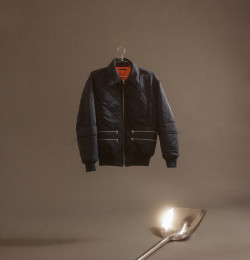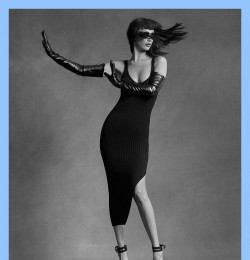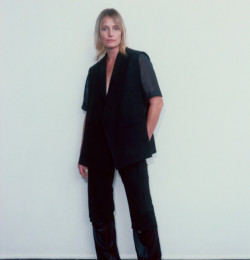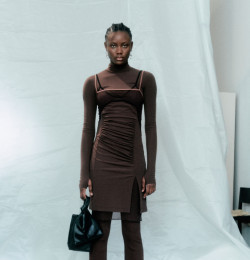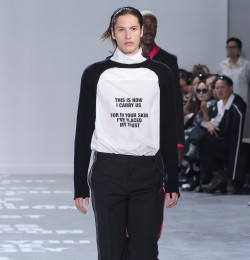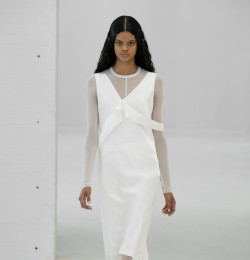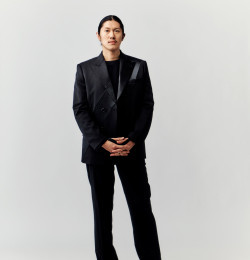

Helmut Lang
New York, NY 10012
USA
About
founded by
Helmut Lang
belongs to
Link Theory Holdings
about
His clothes were fairly successful in his native Austria, and, after a fair exhibition of his clothes at the Centre Pompidou in Paris initated by the Austrian government, he branched out successfully to Paris in 1986 and created the label 'Helmut Lang'. And yet, after communting back and forth between France and Austria, he eventually withdrew from Paris and returned to Vienna in the late 1980s.
At this time in the late 1980s and early 1990s, minimalist fashion was at its height, with Jil Sander, Giorgio Armani and Helmut Lang himself being very popular and successful.
Lang moved to New York in 1997 and subsequently set up his company's headquarters in 142 Greene St. in SoHo in 1998.
Helmut Lang used to make both a women's and men's line, but kept his collection under a single name and presented both lines in one show. He also introduced an underwear (1995) and jeans (1996) line as well as accessories, such as footwear (1990) and and fragrances (1999), but otherwise preferred to keep the brand unified to solidify its identity and strength.
The runway show venues for the Helmut Lang label were switched from Paris (until 1998) to New York and back again to Paris by Prada (from 2002 to 2005). The collections/presentations used to be called 'séances de travail' (French for 'working sessions') by Mr. Lang.
In 1999 Lang entered into collaboration with Prada to open boutiques all over Europe and expand his line. He is now poised to become a major global marketing force, with a Jeans line, a perfume deal with Proctor and Gamble and a leather license in the pipeline.
Prada had acquired 51% of Helmut Lang's company in August 1999. Despite the quality of the clothes and the slight revival of minimalist fashion in the early 2000s, the Helmut Lang brand did not fare well. Prada decided to cancel the Helmut Lang Jeans license, which had been responsible for more than half of the brand's sales, and intended to develop an in-house accessories line. But neither the new accessories nor the fragrances proved a large success. Mr. Lang is said to have insisted that one of his colognes be produced when a test study by the manufacturer-to-be, Procter & Gamble, strongly suggested to modify the scent. After alleged disputes with Prada Group's CEO Patrizio Bertelli on how the brand should be continued and after Mr. Lang had sold his remaining shares to Prada in October.
In September 2004, they took complete control by buying out the remaining 49%. It was announced that Helmut will continue as creative director of the company designing the clothes. Financial details were not disclosed.
In a surprise announcement in January 2005, the Prada Group who own Helmet Lang's company, informed of his departure from his own company. He has been considered a by-word for cool in recent years, and it appears his ideas for running his company were at odds with the Prada management just as Jil Sander's were when she left her own company recently. In March Prada announced that they would close the Helmut Lang showroom in New York. However Helmut is not yet down. He is talking to several major companies about the future.
After Mr. Lang's departure, Prada unsuccessfully tried to continue the collections with an in-house design team. In March 2005, Prada closed down the label's headquarters in SoHo, New York.
In September 2005, Prada announced that production of the lines had been halted. By the end of 2005, all that existed of the brand was its name: the design atelier had been closed, the collections had been discontinued and all of the art-inspired Helmut Lang stores had been shut down (with the exception of the Paris location, to sell remaining stock). The corporate web site, which formerly displayed pictures of the collections, remained online, but the contents could no longer be seen.
On March 17, 2006, Prada Group announced that, after six loss-making years, Link Theory Holdings (LTH) of Tokyo would be acquiring the Helmut Lang brand for an estimated €20 million. This came about three weeks after Prada had sold the Jil Sander label to British equity firm Change Capital Partners (CCP). Already in spring 2005, it had been rumored that Prada was trying to sell the label. Prada Group was said to want to concentrate on its core labels, Prada and Miu Miu, again. The Japanese holding company LTH, developer of the theory fashion label in Japan and the US, was said re-launched the Helmut Lang collections under the direction of a "suitable" designer for the spring/summer 2007 season (presented in fall 2006), in select boutiques worldwide as a “contemporary brand". The new label was said to be based out of New York City. LTH also owns profitable German fashion house Rosner, which it bought in late October 2005, as well as the Joie, PLS+T and Kulson labels.
Rumor had it for a while that Russian-born designer Alexandre Plokhov of menswear label Cloak, a former men's pattern maker for fashion house Marc Jacobs, and winner of the 2005 Swarovski's Perry Ellis Award for Emerging Talent Menswear, might be the new designer for Helmut Lang. It was never, though, expected that Mr. Lang himself would return to the label that bears his name, although Chikara Sasake, president and chief executive of Link-Theory Holdings Company, gave to understand that if Lang “wants to come back, the door is always open”.
In May 2006, it was announced that Michael and Nicole Colovos, an American-New Zealand designer couple, who formerly had their own Los Angeles-based denim label Habitual, had been installed by Link Theory as creative directors for the new Helmut Lang brand.
From February 2007, select upscale retailers such as Barneys or Bergdorf Goodman carry the spring/summer 2007 Helmut Lang contemporary sportswear collection. The design office has been set up in West Chelsea in New York. The collection, described as "a commercial reduction of [Mr. Lang's] fashion identity", has received quite favorable reviews even though it is clearly not seen as a continuation of the original line. The item prices in the collection are about 20% above those for comparable Link Theory items and, hence, below the original Helmut Lang prices. Link Theory expects to generate US$ 8 million in revenues in 2008 and make a profit in 2009 with the label. The company also announced that "over the long term" they intend "to also establish exclusive Helmut Lang shops" in the US, Europe and Japan.
The Helmut Lang web site was re-activated at the end of 2006 and was fully launched in spring 2007.
Mr. Lang, who resides on Long Island of independent means, is said not to be involved in the re-launch in any way.
In March 2007, Link Theory opened the first post-Prada signature Helmut Lang store in Tokyo's fashionable Aoyama district. In Japan, the company has since then installed several Helmut Lang stores-in-store at local department stores. In August 2007, a new freestanding Helmut Lang store was opened on Melrose Avenue in Los Angeles. It is, after the Tokyo store, the second signature Helmut Lang store since the closing of the last original store in Paris. The store, in close proximity to Melrose Place, is adjacent to an existing theory store at 8424 Melrose Avenue. Another Helmut Lang store opened on September 28, 2007 on Maiden Lane in San Francisco, in the building previously occupied by Jil Sander. In New York City, a temporary 'pop-up shop' opened in mid-December 2007, while the company is apparently looking for a larger location in the Meatpacking District.
The Look
The name Helmut Lang has become synonymous with the cerebral brand of minimalism that took the fashion world by storm in the late eighties. Lang's razor-sharp lines and high-tech fabrics are made for only the most disciplined of bodies - even his signature t-shirts, which elevated the clingy tee to couture status, are famously unforgiving (and famously expensive). He has a stark sober palette, often slashed with bright colour, which reflects a modern, even futuristic perspective. His cleverly thought out clothes are cleanly and precisely tailored, but in an exploratory, quirky manner. His fabric combinations reveal a forward-looking approach.
Perfumes
Official Social Media
Latest Helmut Lang Advertisements

